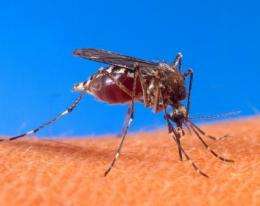Flight patterns reveal how mosquitoes find hosts to transmit deadly diseases

The carbon dioxide we exhale and the odors our skins emanate serve as crucial cues to female mosquitoes on the hunt for human hosts to bite and spread diseases such as malaria, dengue and yellow fever.
Two entomologists at the University of California, Riverside have now performed experiments to study how female Aedes aegypti -- mosquitoes that transmit yellow fever and dengue -- respond to plumes of carbon dioxide and human odor.
The researchers report in the October 15 issue of the Journal of Experimental Biology that puffs of exhaled carbon dioxide first attract these mosquitoes, which then proceed to follow a broad skin odor plume, eventually landing on a human host.
The results from the study by Ring Cardé, a distinguished professor of entomology at the University of California, Riverside, and Teun Dekker, formerly a graduate student in Cardé's lab and now an assistant professor at the Swedish University of Agricultural Research, could clue scientists on how odors can be used in traps for intercepting and capturing host-seeking mosquitoes.
Yellow fever is a viral disease that causes 30,000 deaths worldwide each year. Dengue, another viral disease, infects 50 to 100 million people worldwide a year, leading to half a million hospitalizations, and 12,500,000 deaths.
In the lab, the researchers released female yellow fever mosquitoes into a wind tunnel they built, and filmed their flight paths. They found that:
- Mosquitoes head upwind only briefly when they encounter just a whiff of carbon dioxide but proceed continuously upwind when the carbon dioxide plume is turbulent, fluctuating in concentration and mimicking the presence of a live host.
- Mosquitoes' orientation to human skin odor, in contrast, is optimal when the plume of skin odor is broad and unvarying in its intensity, as would occur when a mosquito closes in on a potential host.
"Carbon dioxide induces a faster and more direct upwind orientation than skin odor," said Cardé, who holds the Alfred M. Boyce Chair in Entomology. "Our experiments show that the response of yellow fever mosquitoes to skin odor requires an exposure longer than that of carbon dioxide to induce upwind flight."
Dekker and Cardé also report that the dynamics -- response time, duration and speed -- of carbon dioxide-induced upwind surging were very similar across a wide range of carbon dioxide concentrations, from 100 to 0.05 percent (barely above atmospheric levels).
"The mosquitoes' carbon dioxide receptors allow the insects to respond almost instantly to even the slightest amount of the gas," Cardé said. "Carbon dioxide alone attracts these mosquitoes and does not require assistance from other odors. Skin odors, however, become important when the mosquito is near the host, selecting biting sites. Further, the mosquitoes' sensitivity to skin odors increases 5- to 25-fold after 'priming' with a whiff of carbon dioxide."
Provided by University of California - Riverside


















